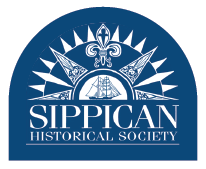
In 1935, The Sketch Book Magazine, a popular publication subtitled Sippican Tales, Past and Present printed a clever poem by a twelve-year-old Julia Gibbs. The poem was entitled, “The Ancient Marioner,” obviously a clever spin on Coleridge’s “Rime of the Ancient Mariner.” It begins,
“It was an ancient Marioner with overalls of blue;
He stands beside the pasture bars to bid his cows come through.”
Of course the farmer goes to sea, becomes a sailor, and ultimately becomes the captain of a whaling ship. Mid-way through the poem, the “captain” tells us,
“‘But Mariner turned Marioner, ere many years had passed;
And that is how I came to be all settled here at last.'”
In a biographical note about the young author, we read that the “Marioner” was based on an actual Marion resident! Click here to read the poem in its entirety, discover the identity of Julia’s inspiration, read about how Marion celebrated the 4th of July in 1935, and see what local merchants were advertising! The entire magazine, and dozens more like it, are preserved in the SHS archives.
However clever this little gem of a poem is, it can only hint at the creativity with which young Julia would later grace the world.
Born in 1866, Julia was educated in England, returning to Boston in 1878 to continue her schooling. She studied art in Boston, then in England and Italy, specializing in mosaics, embroidery, metalwork, and illuminations on vellum. She wrote a number of art books, including The Art of the Pitti Palace, Arts and Crafts in the Middle Ages, and The Boston Museum of Fine Arts, as well as Christmas carols, plays and several novels. A charter member of the Society of Arts and Crafts, she was a recognized expert in the embroidery of ecclesiastical ornaments. In 1889, she married Daniel Dulany Addison, an author and priest of the Episcopal Church, and together they summered in Marion for years.
 St. Gabriel’s Episcopal Church here in Marion is especially fortunate to have two examples of Julia’s work in its chapel. A stained glass window (1884) bearing the image of a dove flying over mountains (seen at the top of this post) was placed in the organ loft above the front entrance in 1914. Just to the right of the organ console at the opposite end of the sanctuary is her stunning triptych of St. Cecilia (the patron saint of music) flanked by two angels. It can be seen here in this post, but is certainly best viewed in person. Both are well worth a visit to this historic chapel!
St. Gabriel’s Episcopal Church here in Marion is especially fortunate to have two examples of Julia’s work in its chapel. A stained glass window (1884) bearing the image of a dove flying over mountains (seen at the top of this post) was placed in the organ loft above the front entrance in 1914. Just to the right of the organ console at the opposite end of the sanctuary is her stunning triptych of St. Cecilia (the patron saint of music) flanked by two angels. It can be seen here in this post, but is certainly best viewed in person. Both are well worth a visit to this historic chapel!
Julia DeWolf Gibbs Addison died in 1952, and is buried in Evergreen Cemetery with her husband. Even their headstone – a Celtic cross, pictured below – is a gorgeous piece of art, befitting the creative spirits it memorializes.
Happy International Women’s Day!

